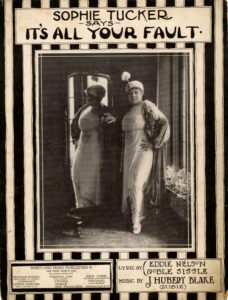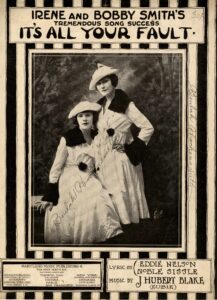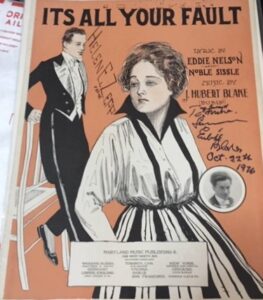YOUR DAILY DOSE OF EUBIE!!!

Sissle and Blake first worked together through the summer and early fall of 1915 in Joe Porter’s group in Baltimore. During this period, the duo wrote their first song, “It’s All Your Fault,” with some help from white singer Eddie Nelson on the lyrics. (Nelson was singing at River View Park at the same time Sissle and Blake were performing there with Porter’s band.) Sissle successfully pitched the song to vaudeville singer Sophie Tucker when she was appearing in town at the Maryland Theater that August. Blake admitted that he lacked Sissle’s gumption to approach this major star with their song:
Sissle says, “Let’s take the song up to Miss Tucker.” I said, “Oh, man, you can’t go to Sophie Tucker, the big star. What are you talking about?” He says, “She can’t kill us; let’s try.” Sissle was more aggressive than I was. He was a fighter, he’s a go-getter. I never was that way. If you didn’t like my music, I just took it and walked away, but he argued with you and sell it to you. He was a good salesman. So we went up to see Miss Tucker. …
So Sissle says, “Will you listen to a song?” [Tucker said,] “Yes, yes, yes, go ahead, go ahead.” She’s a big star, you know. We weren’t nothing. … So we sang it. She said, “I like that song, I like it, I like it. I’ll get orchestrations made this week and do it.” This was on a Monday. On a Wednesday or Thursday, she had [the] orchestrations ready. We didn’t pay for it. I couldn’t make no orchestrations then. You are supposed to make orchestrations and give it to her if people are going to sing the stuff for you. … [but] she said “I’ll have some boys in the band make an orchestration and we’ll put it on.”
Tucker performed the song on stage on August 21, 1915, which the sheet’s publisher, the Maryland Music Co., proudly announced in an advertisement in the Baltimore Sun. The ad described it as “A triumph of the country in Songland, an unprecedented success, such as has never been.” This appears to have been pure puffery, as the song didn’t catch on much beyond Baltimore, according to Blake:
I’ll bet you there wasn’t 10 people in Washington, that’s only 44 miles away, ever heard that song. But everybody in [Baltimore] sang it. We got a hit on our hands! We think it’s a hit. Nobody heard it but in Baltimore. They bought it. I guess it sold about 30,000 copies….

It must have been sufficiently popular to warrant several printings, and was available in both a piano-vocal arrangement and a four-part harmony setting for vocal groups. It appeared with at least three different covers, the most common featuring Tucker’s photo. Another version featured the same basic design but with the sister act Irene and Bobby Smith on the cover. (They also appeared on the cover of “My Loving Baby,” Sissle and Blake’s second published song.) The only press accounts we could find for the sisters were in 1915-1916 when they were appearing at Baltimore’s Victoria Theater. They were promoted as ““Two Girls and A Piano; about the neatest musical act you’ve seen! With novelties!—don’t forget them!”

A third, fancier illustrated cover featured an inset photo of Nelson. Advertisements noted that “the man who sings with the [military] band,” Eddie Nelson, was a featured performer; as we will see, Nelson would play a key role in helping to author Blake’s first published song. The white singer Nelson lived in Baltimore and was “well known to the patrons of the dancing pavilions of many summer resorts” in Maryland. The cover illustration features a white couple so clearly the song was being pitched to that market–not reference is made to Sissle and Blake’s race.
Unlike many other songs composed by black lyricists in this period, it is not written in dialect, nor is the topic stereotypically “black.” It is a fairly conventional love song, which could easily have been written by a white composer. Sissle and Blake’s aim was to write popular songs that would appeal to a broad audience; and while some of their early songs reflect black stereotypes, most are conventional in structure and subject matter.